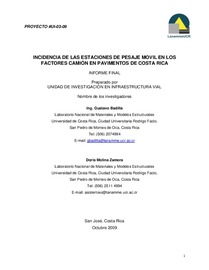Mostrar el registro sencillo del ítem
Incidencia de las estaciones de pesaje móvil en los factores camión en pavimentos de Costa Rica
| dc.contributor.author | Badilla Vargas, Gustavo | |
| dc.contributor.author | Molina Zamora, Doris | |
| dc.date.accessioned | 2018-05-21T20:36:22Z | |
| dc.date.available | 2018-05-21T20:36:22Z | |
| dc.date.issued | 2009-10 | |
| dc.identifier.uri | https://www.lanamme.ucr.ac.cr/repositorio/handle/50625112500/1179 | |
| dc.description.abstract | Se puede notar las diferencias que existen entre los factores camión de una zona a otra, principalmente entre las rutas de la GAM hacia los puertos marítimos y las rutas de menor trasiego de mercancías. Sin embargo, es evidente que las diferencias encontradas entre los factores camión son menores a las que existían en el año 2007, donde por ejemplo para los vehículos C3 en aquel momento el rango de los Factores Camión oscilaba entre 1.43 – 3.08 (lo representa una diferencia de 1.65), mientras que para el año 2009 el rango de valores para el C3 se encuentra entre 0.64 -1.33 (lo que representa una diferencia de 0.69), producto de que el control de pesos permite que las cargas transportadas por los vehículos sean más uniformes. Otra observación importante, se da cuando se analiza la Variación Temporal del Factor Camión, el cual en los primeros meses presenta valores altos, producto de que se da un alto porcentaje de incumplimiento de la reglamentación existente. Una vez, que los transportistas van tomando conciencia del control de pesos en sus vehículos, los valores de los Factores Camión se van reduciendo sucesivamente hasta llegar a estabilizarse a un valor que optimiza el peso máximo que pueden transportar sin exceder la reglamentación existente. Es de gran utilidad ampliar la presente investigación y evaluar las cargas que actualmente se transportan en los autobuses, ya que este tipo de vehículo no está siendo controlado en las estaciones de pesaje móvil, con el objetivo de evitar molestias a los usuarios; sin embargo, en el estudio realizado en el 2007 se observó un alto porcentaje de incumplimiento de la reglamentación vigente y por lo tanto factores camión muy elevados, lo cual requiere prestarle la atención adecuada y tomar las medidas pertinentes. | es |
| dc.description.abstract | One can notice the differences that exist between truck factors from one area to another, mainly between the routes of the GAM to the seaports and the routes of less traffic of goods. However, it is evident that the differences found between truck factors are lower than those that existed in 2007, where for example for C3 vehicles at that time the range of Truck Factors ranged between 1.43 - 3.08 (it represents a difference of 1.65), while for the year 2009 the range of values for C3 is between 0.64 and -1.33 (which represents a difference of 0.69), as a result of which the weight control allows the loads transported by the vehicles to be more uniforms. Another important observation is given when analyzing the Temporary Variation of the Truck Factor, which in the first months presents high values, as a result of which there is a high percentage of non-compliance with the existing regulations. Once the carriers are becoming aware of the control of weights in their vehicles, the values of the Truck Factors are reduced successively until they reach a level that optimizes the maximum weight they can carry without exceeding the existing regulations. It is very useful to extend the present investigation and evaluate the loads that are currently transported in the buses, since this type of vehicle is not being controlled in the mobile weighing stations, in order to avoid inconveniences to the users; However, in the study carried out in 2007, a high percentage of noncompliance with the regulations in force was observed and, therefore, truck factors were very high, which requires adequate attention and appropriate measures. | es |
| dc.language.iso | es | es |
| dc.publisher | Laboratorio Nacional de Materiales y Modelos Estructurales (LanammeUCR) | es |
| dc.relation.ispartofseries | UI-03-09 | |
| dc.subject | transporte público | es |
| dc.subject | bus | es |
| dc.subject | rutas | es |
| dc.subject | cargas | es |
| dc.subject | public transport | es |
| dc.subject | routes | es |
| dc.subject | Loads | es |
| dc.title | Incidencia de las estaciones de pesaje móvil en los factores camión en pavimentos de Costa Rica | es |
| dc.type | informe técnico | es |
| dc.description.procedence | UCR::Vicerrectoría de Investigación::Unidades de Investigación::Ingeniería::LanammeUCR | es |
Ficheros en el ítem
Este ítem aparece en la(s) siguiente(s) colección(ones)
-
Informes [1088]

